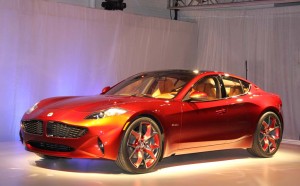As it begins to move ahead with the development of its next model – and lays out plans for future offerings – California-based battery-car start-up Fisker Automotive is focusing attention on the Motor City.
The maker says it is strongly considering a new technical center in the Detroit suburbs, hoping such a facility would help it tap the knowledge of Michigan’s well-established engineering and supplier base. It would actually mark a return to the automotive center, Fisker having closed an earlier facility in the suburbs two years ago.
“This important step signals our commitment to bringing the Fisker Atlantic to market as soon as we can,” Tony Posawatz, Fisker’s new President and CEO said in a statement. “We will be bringing our own engineering footprint closer to our supplier base and the expertise and professional work force that have driven the American automotive industry for more than a century.”
For Posawatz it would be something of a return home. He headed the Chevrolet Volt development program before “retiring” from General Motors barely a year ago. He quickly resurfaced at Fisker, replacing Tom LaSorda, a former Chrysler CEO, as the battery-car company’s chief executive.
It has been a tough year for Fisker, even though it finally got its first product, the Karma plug-in, into production. That launch came months late and led the federal government to freeze a much-needed low-interest loan that was expected to help fund the development and launch of Fisker’s second model, the more mainstream Atlantic.
Fisker was only able to draw down about $193 million of the $529 million Department of Energy loan and has since delayed the launch of the Atlantic until at least 2014 while it scrambles for private sources of capital. It claims to have several $100 million over the last 12 months.
The delay in the launch of the Fisker Atlantic may have a positive side, according to some observers who feel the engineering work on the original Karma wasn’t as complete as needed. The vehicle has won acclaim for its design but has been faulted for its weight and handling. It has received poor marks from such reviewers as the influential Consumer Reports magazine – and it has been involved in two separate recalls.
Those have been triggered by problems with the Karma’s battery – including one incident that led to a destructive fire. Several other Karma fires are under investigation – including an incident that saw a dozen of the plug-ins destroyed after they were submerged in saltwater during Superstorm Sandy at a New Jersey port. It appears saltwater may have shorted out their batteries. A number of other battery vehicles, including a Volvo and a Toyota Prius were destroyed in similar flood-related fires during the storm.
Despite its problems, Fisker promises to move ahead and the Atlantic is seen as the likely make-it-or-break-it product for the brand. An engineering base in the Midwest, especially in Detroit, would position the maker nearby key engineering centers – including operations used by General Motors, Ford and a number of foreign-based makers also working to electrify their line-ups.
The Atlantic, however, will eventually be produced in Delaware – though that would maintain the Detroit connection, as the Fisker factory there was a former General Motors facility.

